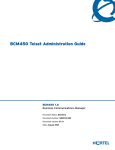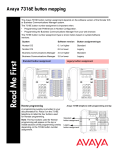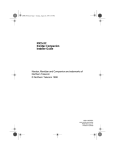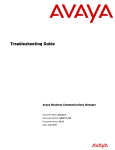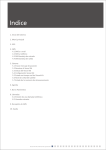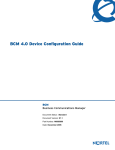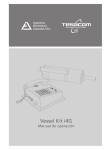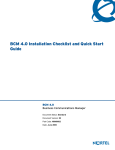Download Avaya BCM 4.0 Telset User's Manual
Transcript
Telset Administration Guide
BCM 4.0
Business Communications Manager
Document Status: Standard
Document Version: 03
Part Code: N0060610
Date: June 2006
Copyright © Nortel Networks Limited 2006
All rights reserved.
The information in this document is subject to change without notice. The statements, configurations, technical data, and
recommendations in this document are believed to be accurate and reliable, but are presented without express or implied
warranty. Users must take full responsibility for their applications of any products specified in this document. The
information in this document is proprietary to Nortel Networks.
Trademarks
*Nortel, Nortel (Logo), the Globemark, and This is the way, This is Nortel (Design mark) are trademarks of Nortel
Networks.
*Microsoft, MS, MS-DOS, Windows, and Windows NT are registered trademarks of Microsoft Corporation.
All other trademarks and registered trademarks are the property of their respective owners.
Contents
3
Contents
Getting started with BCM . . . . . . . . . . . . . . . . . . . . . . . . . . . . . . . . . . . . . . . . 5
About this guide . . . . . . . . . . . . . . . . . . . . . . . . . . . . . . . . . . . . . . . . . . . . . . . . . . . . . . . 5
Purpose . . . . . . . . . . . . . . . . . . . . . . . . . . . . . . . . . . . . . . . . . . . . . . . . . . . . . . . . . . 5
Audience . . . . . . . . . . . . . . . . . . . . . . . . . . . . . . . . . . . . . . . . . . . . . . . . . . . . . . . . . . . . 5
Acronyms . . . . . . . . . . . . . . . . . . . . . . . . . . . . . . . . . . . . . . . . . . . . . . . . . . . . . . . . . . . . 6
Symbols and conventions used in this guide . . . . . . . . . . . . . . . . . . . . . . . . . . . . . . . . . 6
Related publications . . . . . . . . . . . . . . . . . . . . . . . . . . . . . . . . . . . . . . . . . . . . . . . . . . . 8
How to get Help . . . . . . . . . . . . . . . . . . . . . . . . . . . . . . . . . . . . . . . . . . . . . . . . . . . . . . . 8
Administration telset interfaces . . . . . . . . . . . . . . . . . . . . . . . . . . . . . . . . . . 11
Initial setup telset menus . . . . . . . . . . . . . . . . . . . . . . . . . . . . . . . . . . . . . . . . . . . . . . . 11
Using FEATURE 9*8 for initial configuration . . . . . . . . . . . . . . . . . . . . . . . . . . . . . . . . 12
Logging in to the F9*8 interface . . . . . . . . . . . . . . . . . . . . . . . . . . . . . . . . . . . . . . 12
Entering keycodes and feature settings . . . . . . . . . . . . . . . . . . . . . . . . . . . . . . . . 14
Activating user accounts and changing passwords . . . . . . . . . . . . . . . . . . . . . . . 15
Viewing or entering IP network information . . . . . . . . . . . . . . . . . . . . . . . . . . . . . . 15
System restart . . . . . . . . . . . . . . . . . . . . . . . . . . . . . . . . . . . . . . . . . . . . . . . . . . . . 17
Using the telset configuration interface . . . . . . . . . . . . . . . . . . . . . . . . . . . 19
Programming with the telset telephony interface . . . . . . . . . . . . . . . . . . . . . . . . . . . . . 19
User access to the FEATURE**CONFIG interface . . . . . . . . . . . . . . . . . . . . . . . . . . . 20
Programming telephones . . . . . . . . . . . . . . . . . . . . . . . . . . . . . . . . . . . . . . . . . . . . . . 21
Navigating the telset menus . . . . . . . . . . . . . . . . . . . . . . . . . . . . . . . . . . . . . . . . . 21
Top-level menu of the telset telephony configuration tree . . . . . . . . . . . . . . . . . . . . . . 25
About the FEATURE **CONFIG menu system . . . . . . . . . . . . . . . . . . . . . . . . . . . . . . 25
Terminals and Sets . . . . . . . . . . . . . . . . . . . . . . . . . . . . . . . . . . . . . . . . . . . . . . . . 26
Lines . . . . . . . . . . . . . . . . . . . . . . . . . . . . . . . . . . . . . . . . . . . . . . . . . . . . . . . . . . . 31
Services . . . . . . . . . . . . . . . . . . . . . . . . . . . . . . . . . . . . . . . . . . . . . . . . . . . . . . . . 33
System speed dials . . . . . . . . . . . . . . . . . . . . . . . . . . . . . . . . . . . . . . . . . . . . . . . . 36
Passwords . . . . . . . . . . . . . . . . . . . . . . . . . . . . . . . . . . . . . . . . . . . . . . . . . . . . . . . 37
Time and Date . . . . . . . . . . . . . . . . . . . . . . . . . . . . . . . . . . . . . . . . . . . . . . . . . . . . 38
System programming . . . . . . . . . . . . . . . . . . . . . . . . . . . . . . . . . . . . . . . . . . . . . . 39
Telco features . . . . . . . . . . . . . . . . . . . . . . . . . . . . . . . . . . . . . . . . . . . . . . . . . . . . 46
Hardware . . . . . . . . . . . . . . . . . . . . . . . . . . . . . . . . . . . . . . . . . . . . . . . . . . . . . . . . 47
Maintenance . . . . . . . . . . . . . . . . . . . . . . . . . . . . . . . . . . . . . . . . . . . . . . . . . . . . . 49
Usage metrics . . . . . . . . . . . . . . . . . . . . . . . . . . . . . . . . . . . . . . . . . . . . . . . . . . . . 51
Index . . . . . . . . . . . . . . . . . . . . . . . . . . . . . . . . . . . . . . . . . . . . . . . . . . . . . . . . 53
BCM 4.0 Telset Administration Guide
4
Contents
N0060610
5
Getting started with BCM
This section contains information on the following topics:
•
•
•
•
•
•
“About this guide” on page 5
“Audience” on page 5
“Acronyms” on page 6
“Symbols and conventions used in this guide” on page 6
“Related publications” on page 8
“How to get Help” on page 8
About this guide
The BCM 4.0 Telset Administration Guide describes how to use the Telset interface to administer
your BCM system. The telset configuration is a tool that is used for system configuration if there is
no network connection to your BCM. In this guide, BCM Release 4.0 refers to BCM 200, BCM
400, and BCM 1000 main units that are running the BCM Release 4.0 software.
Purpose
The tasks described in the guide relate to the inital setup of the BCM system, and the configuration
of telephone sets.
In brief, the information in this guide explains:
•
•
•
•
•
start-up programming
keycodes and feature settings
activating user accounts and changing passwords
viewing and entering IP network information
programming telephones
Audience
The BCM 4.0 Telset Administration Guide is directed to network administrators responsible for
maintaining BCM networks. This guide is also useful for network operations center (NOC)
personnel supporting a BCM managed services solution. To use this guide, you must:
•
•
•
be an authorized BCM administrator within your organization
know basic Nortel BCM terminology
be knowledgeable about telephony and IP networking technology
BCM 4.0 Telset Administration Guide
6
Getting started with BCM
Acronyms
The following is a list of acronyms used in this guide.
Table 1 List of acronyms
Acronym
Description
BCM
Business Communications Manager
BRI
Basic Rate Interface
DHCP
Dynamic Host Configuration Protocol
DN
Directory Number
IP
Internet Protocol
ISDN
Integrated Switched Digital Network
NOC
Network Operations Center
ONN
Outgoing Name and Number
PRI
Primary Rate Interface
SM
Silent Manager
Symbols and conventions used in this guide
These symbols are used to highlight critical information for the BCM system:
Caution: Alerts you to conditions where you can damage the equipment.
Danger: Alerts you to conditions where you can get an electrical shock.
Warning: Alerts you to conditions where you can cause the system to fail or work
improperly.
Note: A Note alerts you to important information.
Tip: Alerts you to additional information that can help you perform a task.
N0060610
Getting started with BCM
!
7
Security note: Indicates a point of system security where a default should be changed,
or where the administrator needs to make a decision about the level of security required
for the system.
Warning: Alerts you to ground yourself with an antistatic grounding
strap before performing the maintenance procedure.
Warning: Alerts you to remove the BCM main unit and expansion unit
power cords from the ac outlet before performing any maintenance
procedure.
These conventions and symbols are used to represent the Business Series Terminal display and
dialpad.
Convention
Example
Used for
Word in a special font (shown in
the top line of the display)
Pswd:
Command line prompts on display telephones.
Underlined word in capital letters
(shown in the bottom line of a two
line display telephone)
PLAY
Display option. Available on two line display
telephones. Press the button directly below the
option on the display to proceed.
Dialpad buttons
£
Buttons you press on the dialpad to select a
particular option.
These text conventions are used in this guide to indicate the information described:
Convention
Description
bold Courier
text
Indicates command names and options and text that you need to enter.
Example: Use the info command.
Example: Enter show ip {alerts|routes}.
italic text
Indicates book titles
plain Courier
text
Indicates command syntax and system output (for example, prompts
and system messages).
Example: Set Trap Monitor Filters
FEATURE
HOLD
RELEASE
Indicates that you press the button with the coordinating icon on
whichever set you are using.
BCM 4.0 Telset Administration Guide
8
Getting started with BCM
Related publications
Related publications are listed below. To locate specific information, you can refer to the
Master Index of BCM 4.0 Library.
Keycode Installation Guide (N0060625)
CallPilot Telephone Administration Guide (N0060618)
BCM 4.0 Administration Guide (N0060598)
How to get Help
This section explains how to get help for Nortel products and services.
Getting Help from the Nortel Web site
The best way to get technical support for Nortel products is from the Nortel Technical Support
Web site:
http://www.nortel.com/support
This site provides quick access to software, documentation, bulletins, and tools to address issues
with Nortel products. More specifically, the site enables you to:
•
download software, documentation, and product bulletins
•
search the Technical Support Web site and the Nortel Knowledge Base for answers to
technical issues
•
sign up for automatic notification of new software and documentation for Nortel equipment
•
open and manage technical support cases
Getting Help over the phone from a Nortel Solutions Center
If you don’t find the information you require on the Nortel Technical Support Web site, and have a
Nortel support contract, you can also get help over the phone from a Nortel Solutions Center.
In North America, call 1-800-4NORTEL (1-800-466-7835).
Outside North America, go to the following Web site to obtain the phone number for your region:
http://www.nortel.com/callus
Getting Help from a specialist by using an Express Routing Code
To access some Nortel Technical Solutions Centers, you can use an Express Routing Code (ERC)
to quickly route your call to a specialist in your Nortel product or service. To locate the ERC for
your product or service, go to:
N0060610
Getting started with BCM
9
http://www.nortel.com/erc
Getting Help through a Nortel distributor or reseller
If you purchased a service contract for your Nortel product from a distributor or authorized
reseller, contact the technical support staff for that distributor or reseller.
BCM 4.0 Telset Administration Guide
10
Getting started with BCM
N0060610
11
Administration telset interfaces
You can use Element Manager or you can use the Telset interface to administer your BCM system.
The telset configuration is a tool that is used for system configuration if there is no network
connection to your BCM, or for quick configuration changes, such as changing features in a DN
record or updating one of the speed dial lists. Administration telset interfaces are accessible only
by a user with an Installer level of telset user privileges. These menus are used at initial startup or
to make changes to security-sensitive system settings.
•
•
“Initial setup telset menus” on page 11
“Using FEATURE 9*8 for initial configuration” on page 12
Initial setup telset menus
The initial telset menus are used during the initial configuration of your system. The user requires
Installer (Administrator) level of password to use these menus. The following three features must
be done within 15 minutes of power up:
FEATURE
**7763453
(**PROFILE)
should only be run at the initial set up if the Startup profile did
not properly set the country profile on your system and the
Element Manager is not accessible to perform this task.
FEATURE
**3425723
(**DIALPAD)
allows you to change how the system receives Q and Z in
the telset interface.
FEATURE
**7827887
(**STARTUP)
should only be run at the initial set up if the Startup profile did
not set the telephony profile to the correct setting and the
Element Manager is not accessible to perform this task. Note
that using this interface returns your system to the default
state
Figure 1 Menus for profiles and dialpad function for startup programming
BCM 4.0 Telset Administration Guide
12
Administration telset interfaces
Using FEATURE 9*8 for initial configuration
FEATURE 9*8 provides access to menus that allow you to:
•
•
•
•
•
add a keycode for applications such as mail boxes, Fax suite, and private networking. See
“Entering keycodes and feature settings” on page 14
change user accounts and passwords. See “Activating user accounts and changing passwords”
on page 15
view or set the IP network addressing. See Viewing or entering IP network information on
page 15
enable or disable the soft modem. See “System restart” on page 17
restart your system. See “System restart” on page 17
Logging in to the F9*8 interface
An administration-level telset username and password are required to access this interface. Use the
following user ID and password to access the FEATURE 9*8 feature:
User ID
SETNNA (738662)
Password
CONFIG (266344)
For more information about accessing the telset interfaces, and about which telephones can be
used to access the interface, refer to “Using the telset configuration interface” on page 19. Note
that this interface does not use the keypad directional arrows that are used for the telephony
interface, but rather follows the conventions of the CallPilot F983 interface, which uses display
prompts to navigate through the menus.
N0060610
Administration telset interfaces
13
Figure 2 Log in menu
When a user enters an incorrect password, the system provides a display indicating that there is an
entry error. If the user tries repeatedly to enter an invalid username or password, the system locks
the user account. The user can wait until the lockout timer releases the account, or the account can
be released through this telset menu by a user with administration privileges or through the
Element Manager by a user with administration privileges. The lockout timer and the lockout
release can be configured in the Element Manager.
BCM 4.0 Telset Administration Guide
14
Administration telset interfaces
Entering keycodes and feature settings
Features List provides a list of applications that have applied keycodes in the system. When you
add applications or increase a feature capacity, you can make those adjustments through this menu.
For details about keycodes, refer to Keycode Installation Guide.
Figure 3 shows the layout for Features List.
Figure 3 Accessing the Features List
N0060610
Administration telset interfaces
15
Activating user accounts and changing passwords
User Accounts provides two menus, one to create or delete user accounts and the other to enter
new passwords for user accounts. The username and password can each be 16 digits in length.
Figure 4 shows the layout for User Accounts.
Figure 4 Accessing user accounts and passwords
Viewing or entering IP network information
IP Address allows you to view IP network information on systems where DHCP is enabled. On
systems where DHCP is disabled, you can enable DHCP or enter static IP network information.
BCM 4.0 Telset Administration Guide
16
Administration telset interfaces
Figure 5 shows the layout for IP Address.
Figure 5 Viewing or setting the IP network information
N0060610
Administration telset interfaces
17
System restart
The System Restart heading allows you to reboot the BCM 4.0 main unit. Use this when changes
you have made indicate that a reboot is required.
Warning: Restarting the system interrupts system service.
Figure 6 shows the layout for System Restart.
Figure 6 Restarting the system
BCM 4.0 Telset Administration Guide
18
Administration telset interfaces
N0060610
19
Using the telset configuration interface
This section provides maps of the telset configuration menus. The telset configuration is a tool that
is used for system configuration if there is no network connection to your BCM, or for quick
configuration changes, such as changing features in a DN record or updating one of the speed dial
lists.
Although these menus have most of the features found in the Element Manager user interface, they
are not necessarily in the same location. The goal of this section is to help you quickly locate
feature programming within the telset configuration menus.
Note: For telset admininstration for CallPilot Vmail via F983, see the
Call Pilot Telephone Administration Guide.
Programming with the telset telephony interface
When your system is installed, your installer, or customer service representative, programs it to
work with your telephone lines, with your private network if you have one, and with optional
equipment. In some cases, they also can provide customization for your specific office
requirements. If your system is connected to an IP network, the Element Manager interface
provides the most complete access for system programming and any post-installation adjustments
you may want to make.
However, if your system is not connected to an IP network, or if your system administrators do not
have access to a computer with the Element Manager installed, you can use the telset configuration
interface to program or customize your system setttings.
Some settings will need to be updated regularly, because of staff requirements or new business
contacts, and it is sometimes easier to make quick changes through this menu rather than through
the Element Manager.
There are four ways to use the teleset configuration interface to customize and maintain your BCM
system:
•
Initial programming is performed for you by your installer or customer service representative.
This establishes how the system interacts with lines, telephones, and other equipment. The
user who performs the initial programming also has access to the FEATURE 9*8 telset
configuration menu, which allows access to system administration features.
•
Post-installation programming, for example to change how features work for the system, is
performed by a user assigned as a system coordinator.
•
Post-installation programming for basic configuration changes can be provided to the telset
user without exposing the more sensitive programming areas. For example:
— set user information (FEATURE **user (FEATURE **8737))
— set the Q and Z on the dialpad (FEATURE **dialpad (FEATURE **3425723))
BCM 4.0 Telset Administration Guide
20
Using the telset configuration interface
•
Personal programming, to change functions related to how the telephone works, is available to
anyone through the Feature button on the telephone.
User access to the FEATURE**CONFIG interface
User identification and user passwords are required to access the telset configuration menus
(FEATURE **CONFIG). Although there are a set of default user IDs and passwords, for security
purposes it is recommended strongly that these be changed as part of the initial startup activities.
Also, it is recommended that each user has a unique user ID and password. This allows for more
accurate usage tracking.
User identification and passwords for the telset interface are defined either in the Element
Manager or by using the FEATURE 9*8 telset administration menu, see “Using FEATURE 9*8
for initial configuration” on page 12, which is only accessible to users with administrator
(Installer) privileges.
There are four levels of user access for the telset telephony configuration menus. These are
described in the Table 1. Refer to the system administration information for the Element Manager
for information about assigning these access privilege levels to users. Refer to “Activating user
accounts and changing passwords” on page 15 through that interface.
A user with Installer or System coordinator+ privileges can also use the Password heading in this
menu to change passwords for each privilege level.
Table 1 User access privileges
Access privilege levels
Description of access
Installer
Has full access to all telset menus, including FEATURE 9*8.
System coordinator+
Has full access to all telset telephony menus relating to telephony
system or device set up.
System coordinator
Has more limited access to telset telephony menus relating to
telephony system and device set up. For example, this level of user
cannot define trunks.
Basic
Has access limited to changing DN record information.
Debug
In addition, there are two default telset access passwords for the voicemail and call center telset
menus. Refer to the BCM 4.0 Administration Guide for details.
N0060610
Using the telset configuration interface
21
Programming telephones
To access and use the telset configuration menus, you require a digital or IP telephone with a
two-line display.
Both the 7316E digital phone and the 2004 IP phone, shown in Figure 7, can be used for this
purpose.
Figure 7 Digital phone and IP phone
7316E digital
phone
2004
IP phone
Navigating the telset menus
Digital and IP phones use slightly different methods of navigating through the telset menus. This
section contains the following information:
•
“Using a digital phone to navigate” on page 21
•
“Using an IP phone to navigate the menus” on page 22
•
“What the navigation headings and directions mean” on page 23
•
“Activating menu prompts” on page 23
Using a digital phone to navigate
When you use a 7316 or 7316E digital phone for telset programming, a group of buttons on the
telephone are used to move through programming headings and settings. The programming
overlay is used to relabel the four buttons used during programming. The overlay is supplied with
each telephone.
BCM 4.0 Telset Administration Guide
22
Using the telset configuration interface
Figure 8 7316E digital phone with programming overlay
7316E programming
indicators
Place overlay over keys with
indicators
Heading
Back
Show
Next
Heading
Back
Show
Next
Navigation headings
HEADING
SHOW
BACK
NEXT
Business
Series
Terminals
Programming
Record
7316 programming
indicators
Using an IP phone to navigate the menus
IP telephones use the telephone directional buttons to move through the menu. The active
navigation buttons are shown as a small icon on the far left beside the message prompt.
See Figure 9.
Figure 9 Display and buttons, IP phone
DN: <DN #>
<Company name>
<telset menu prompt>
Navigation
icons
Feature
cmd1
cmd2
cmd3
Navigation buttons
BACK
HEADING
SHOW
NEXT
N0060610
Using the telset configuration interface
23
What the navigation headings and directions mean
Figure 10 shows how the headings on the overlay and the navigational buttons on the IP phone are
used to navigate the programming menus.
Figure 10 How the navigation buttons work
Programming buttons are active or inactive at different stages of programming. On the digital
phone, a button is active (meaning you can use that option), when the indicator next to it is
lit ( or ).
On the IP phone, the navigation icons display the directional arrows that are active.
Activating menu prompts
Both telephones display the same menu prompts and action prompts that require the user to press
the display buttons to perform actions related to the current menu choice. Refer to Figure 11 and
Figure 12 for examples of each type of display.
BCM 4.0 Telset Administration Guide
24
Using the telset configuration interface
Figure 11 Display and buttons, digital phone
Show line:
Display text
COPY
Display button command
Display button
Figure 12 Display and buttons, IP phone
<line>
Conference
Last num redial
<Answer DN>
Intercom
Intercom
DN: <DN #>
<Company name>
<telset menu prompt>
Navigation
icons
Display text
Feature
cmd1
cmd2
Feature
button and
static
display
prompt
Display button command
Display buttons
Navigation buttons
BACK
HEADING
SHOW
NEXT
N0060610
cmd3
Using the telset configuration interface
25
Top-level menu of the telset telephony configuration tree
Figure 13 describes the contents of each top-level menu on the FEATURE **266344
(**CONFIG) telephony configuration tree. Use the navigation buttons to move through the levels
of the tree.
In this section, main headings and their menus are color-coded.
Figure 13 Top-level menus of **CONFIG telset interface
About the FEATURE **CONFIG menu system
The following pages provide a number of flow charts that show the various levels of the telset
configuration tree. Note that the arrows indicate which navigation button is required to move to the
next level.
•
“Terminals and Sets” on page 26
•
“Lines” on page 31
•
“Services” on page 33
BCM 4.0 Telset Administration Guide
26
Using the telset configuration interface
•
“System speed dials” on page 36
•
“Time and Date” on page 38
•
“System programming” on page 39
•
“Telco features” on page 46
•
“Hardware” on page 47
•
“Maintenance” on page 49
•
“Usage metrics” on page 51
Terminals and Sets
Figure 14 through Figure 17 show the headings under the Terminals and Sets menu. These
records are used to set up System DN's for Telephones, and system devices.
N0060610
Using the telset configuration interface
27
Figure 14 Terminals and Sets (Sheet 1 of 4)
BCM 4.0 Telset Administration Guide
28
Using the telset configuration interface
Figure 15 Terminals and Sets (Sheet 2 of 4)
N0060610
Using the telset configuration interface
29
Figure 16 Terminals and Sets (Sheet 3 of 4)
BCM 4.0 Telset Administration Guide
30
Using the telset configuration interface
Figure 17 Terminals and Sets (Sheet 4of 4)
N0060610
Using the telset configuration interface
31
Lines
Figure 18 and Figure 19 show the headings under the telset interface Lines heading. These records
are used to set up individual lines that connect to the system from an external source.
Figure 18 Lines (Sheet 1 of 2)
BCM 4.0 Telset Administration Guide
32
Using the telset configuration interface
Figure 19 Lines (Sheet 2 of 2)
N0060610
Using the telset configuration interface
33
Services
Figure 20, Figure 21 and Figure 22 show the headings under the telset interface Services heading.
These records are used to set up scheduling for ring groups, restrictions, and routing. The ring
groups also are set up under this heading.
Figure 20 Services (Sheet 1 of 3)
BCM 4.0 Telset Administration Guide
34
Using the telset configuration interface
Figure 21 Services (Sheet 2 of 3)
N0060610
Using the telset configuration interface
35
Figure 22 Services (Sheet3 of 3)
BCM 4.0 Telset Administration Guide
36
Using the telset configuration interface
System speed dials
Figure 23 shows the headings under the telset interface System speed dials heading. These
records are used to set up lists of numbers that are accessed through a two- or three-digit code.
Figure 23 System speed dials
N0060610
Using the telset configuration interface
37
Passwords
Figure 24 shows the headings under the telset interface Passwords heading. These records are
used to adjust the passwords for the following system features:
•
COS passwords
•
Call log passwords
•
Hospitality passwords
•
SM (silent monitor) password
Figure 24 Feature passwords
BCM 4.0 Telset Administration Guide
38
Using the telset configuration interface
Time and Date
Figure 25 shows the headings under the telset interface Time and Date heading. These records are
used to adjust the time and date for the system. This is the time and date that appears on each
telephone.
Figure 25 Time and Date
N0060610
Using the telset configuration interface
39
System programming
Figure 26 through Figure 32 shows the headings under the telset interface System prgrming
heading. These records are used to program global telephony settings. This includes the special
features for Hunt groups and Hospitality services.
Figure 26 System prgming (Sheet 1 of 7)
BCM 4.0 Telset Administration Guide
40
Using the telset configuration interface
Figure 27 System prgming (Sheet 2 of 7)
N0060610
Using the telset configuration interface
41
Figure 28 System prgming (page 3 of 7)
BCM 4.0 Telset Administration Guide
42
Using the telset configuration interface
Figure 29 System prgming (Sheet 4 of 7)
N0060610
Using the telset configuration interface
43
Figure 30 System prgming (page 5 of 7)
BCM 4.0 Telset Administration Guide
44
Using the telset configuration interface
Figure 31 System prgming (Sheet 6 of 7)
N0060610
Using the telset configuration interface
45
Figure 32 System prgming (Sheet 7 of 7)
BCM 4.0 Telset Administration Guide
46
Using the telset configuration interface
Telco features
Figure 33 shows the headings under the telset interface Telco features heading. These records are
used to program external voicemail numbers, and to program the outgoing name and number
(ONN) blocking for analog and BRI trunks.
Figure 33 Telco features
N0060610
Using the telset configuration interface
47
Hardware
Figure 34 and Figure 35 show the headings under the telset interface Hardware heading. These
records are used to program the ports on the main unit and any modules connected to the system
through the expansion units.
Figure 34 Hardware (Sheet 1 of 2)
BCM 4.0 Telset Administration Guide
48
Using the telset configuration interface
Figure 35 Hardware (page 2 of 2)
N0060610
Using the telset configuration interface
49
Maintenance
Figure 36 shows the headings under the telset interface Maintenance heading. These records are
used to test or view statistics about the telephony system.
Figure 36 Maintenance (Sheet 1 of 2)
BCM 4.0 Telset Administration Guide
50
Using the telset configuration interface
Figure 37 Maintenance (Sheet 2 of 2)
N0060610
Using the telset configuration interface
51
Usage metrics
Figure 38 shows the headings under the telset interface Usage Metrics heading. These records are
used to display performance records.
Figure 38 Usage Metrics
BCM 4.0 Telset Administration Guide
52
Using the telset configuration interface
N0060610
53
Index
Numerics
7316E overlay 22
C
Conventions, guide 6
button options 6
buttons 6
command line 6
copyright 2
D
Display 6
I
installer programming 19
O
overlay 21
P
personal programming 20
programming
customizing your system 19
installer programming 19
personal programming 20
programming indicatorª 23
programming indicatorº 23
programming overlay 21
R
regulatory information 2
related publications 8
S
Symbols 6
T
trademarks 2
U
user programming 20
BCM 4.0 Telset Administration Guide
54
Index
N0060610






















































